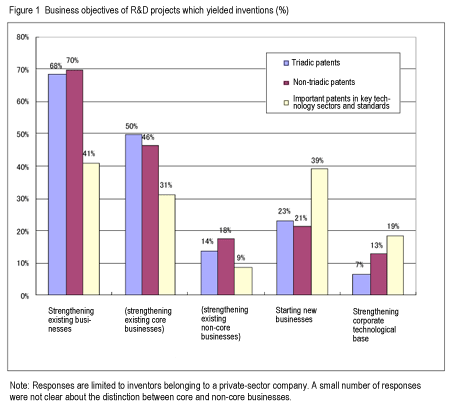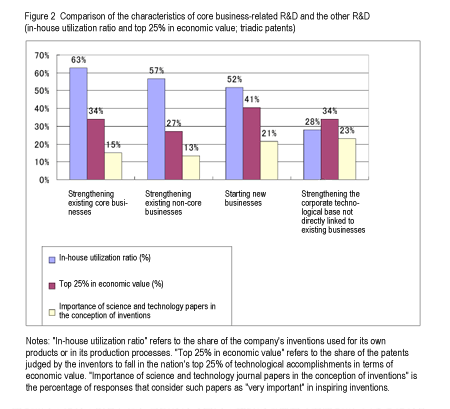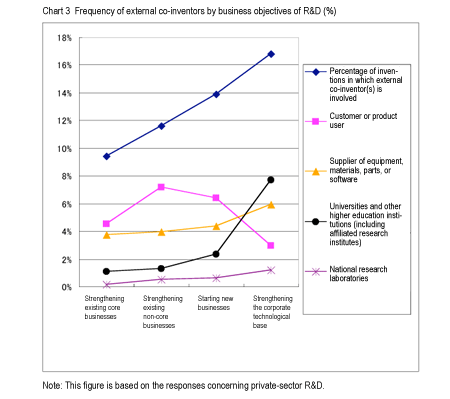Purpose of RIETI inventors survey
Efficient research and development (R&D) at companies and universities and its resulting innovations are considered vital to the future growth of the Japanese economy. However, social scientific knowledge on the objectives and motives of R&D, knowledge sources for innovation, outgoing spillovers, financial constraints on R&D, factors restricting the use of R&D results, and the motivations of inventors is extremely limited. By collecting such information directly from those engaged in R&D, we should be able to substantially deepen our understanding of the structural characteristics of R&D in Japan and contribute to the advancement of policy research. With such goals in mind, RIETI conducted a survey of inventors playing a key role in R&D in Japan about their inventions and the underlying R&D projects. The survey, which is part of the RIETI project titled "Structural Characteristics of Japanese Corporate Research and Development and Issues for the Future," was undertaken from January to June 2007 and amassed nearly 5,300 responses. It is the first systematic R&D project survey ever conducted in Japan.1
In what follows, I will introduce some of the findings from this survey, focusing on the analysis of Japanese companies' R&D characteristics from the viewpoint of corporate business strategy. Three types of sample data were collected by the RIETI inventors survey. The first and largest sample group consists of "triadic patents," inventions for which the patent applications have been filed with all three major patent authorities - the Japan Patent Office (JPO), United States Patent and Trademark Office (USPTO), and European Patent Office (EPO) - and that have been patented in the U.S. The sample data included in this group constitute roughly 70% of the total sample data collected. The second group, referred to as "non-triadic patents," which are not triadic, constitutes 30%. The third group includes a very small number (about 120) of "important patents," the inventions in key technology areas such as nano-technology and new materials, or essential patents for standards. The majority of these patents claimed a priority year, or filing year, from between 1995 and 2001.
Business objectives of R&D
In the area of R&D, in which the importance of "selectivity and focus" has been emphasized as in many other areas of business activities, how much of the R&D is focused on the R&D for strengthening the core business2 and on that for the other business areas respectively, and what trade-offs do companies face in core- and non-core business areas? Figure 1 indicates the inventors' responses to these questions. As it shows, the results for triadic patents are similar to those for non-triadic patents. "Strengthening existing businesses" accounts for about 70% of the responses, while "starting new businesses" and "strengthening the corporate technological base not directly linked to existing businesses" are some 20% and 10% respectively.
Trade-offs in R&D by business objective
The R&D project directly related to a firm's core business is likely to have an advantage in that the research results are likely to be used internally since a firm has the assets complementary to such R&D. Thus, for the companies undertaking such R&D, it is easy to find the profitable applications of the research results even if they happen to be minor technological improvement. On the other hand, such R&D is restricted by the availability of existing complementary assets such as the manufacturing and other facilities and this can potentially hinder making a technological leap. These observations suggest that although the ratio of in-house utilization rate of R&D results in core businesses is relatively high, it involves a trade-off with the constraints on absorbing new scientific and technological knowledge. Indeed, the results consistent with these views are shown in Figure 2 below, which compares the characteristics of R&D for triadic patents between that related and not related to the core business areas. The percentage of the patents from the R&D used internally is shown to be highest for the core business-related R&D, at 63%. However, the figure also shows that science and technology research papers have been used less for the conception of the inventions in this type of R&D than in those for starting a new business or for strengthening the corporate technological base; the percentage of respondents who rated the importance of the science and technology journal papers as "extremely important" for the conception of inventions was 21% for the R&D aimed at starting a new business, compared to 15% for the R&D intended to strengthen the existing core businesses. Likewise, the ratio at which R&D results are considered to rank in the top 25% in terms of the economic value of a patent is higher for R&D for starting a new business.
Cooperation in R&D: Collaboration with users, suppliers, and universities
The more companies try to diversify away from their core businesses, the greater their necessity to deepen their understanding of the market and to acquire new technological capabilities, so too is the importance of building cooperative relationships with external organizations in R&D. Figure 3 below shows the frequency at which external entities are involved in R&D as co-inventors by type of entity and the business objective of R&D. According to this figure, as expected, the share of the co-inventions with an external entity is the lowest when the business objective of R&D is to strengthen the existing core businesses (only 10% of inventions). The share is the highest for the R&D aimed at strengthening the technology base, at 17%, followed by the R&D for starting a new business, then by non-core business-related R&D. In all cases except those aimed at strengthening the technology base, a customer or product user is the most frequent co-inventor, followed by a supplier of equipment, materials, parts, or software. Thus users play an important role in R&D related to current business lines. In contrast, researchers at institutes of higher education, such as universities, are the most frequent co-inventors in R&D aimed at strengthening the technology base.
Future activities
I have briefly introduced the findings from our survey of R&D in Japan, focusing on the analysis of its relationship with business strategy. An overview of the full scope of the survey findings can be found in our discussion paper (in Japanese), "Innovation Process in Japan: Some findings from the RIETI Inventors Survey." In cooperation with the Georgia Institute of Technology, we have also conducted a similar survey in the United States, using a highly similar questionnaire, as we believe it is important to compare Japan's innovation process with that of the U.S. The results of the comprehensive analysis of survey findings, including those in the U.S., was be presented in the RIETI policy symposium, "Innovation Process and Performance: Findings and lessons from inventors surveys in Japan, the U.S., and Europe," held in Tokyo on January 11, 2008. International comparative analysis should provide a clearer picture of the structural characteristics of innovation in Japan, enabling us to have more in-depth discussion of the future direction of innovation.





